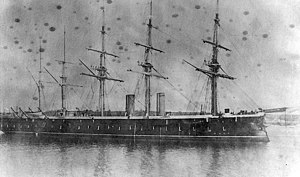 Agincourt at anchor
| |
| History | |
|---|---|
| Name | Agincourt |
| Namesake | Battle of Agincourt |
| Ordered | 2 September 1861 |
| Builder | Laird, Son & Co., Birkenhead |
| Laid down | 30 October 1861 |
| Launched | 27 March 1865 |
| Completed | 19 December 1868 |
| Commissioned | June 1868 |
| Decommissioned | 1889 |
| Out of service | Hulked, 1909 |
| Renamed |
|
| Reclassified | Training ship, 1893 |
| Fate | Scrapped, 21 October 1960 |
| General characteristics (as completed) | |
| Class and type | Minotaur-class armoured frigate |
| Displacement | 10,627 long tons (10,798 t) |
| Length | 407 ft (124.1 m) (o/a) |
| Beam | 59 ft 6 in (18.1 m) |
| Draught | 26 ft 10 in (8.2 m) |
| Installed power |
|
| Propulsion |
|
| Sail plan | 5-masted |
| Speed | 14 knots (26 km/h; 16 mph) |
| Range | 1,500 nmi (2,800 km; 1,700 mi) at 7.5 knots (13.9 km/h; 8.6 mph) |
| Complement | 800 |
| Armament |
|
| Armour | |
HMS Agincourt was a Minotaur-class armoured frigate built for the Royal Navy during the 1860s. She spent most of her career as the flagship of the Channel Squadron's second-in-command. During the Russo-Turkish War of 1877–1878, she was one of the ironclads sent to Constantinople to forestall a Russian occupation of the Ottoman capital. Agincourt participated in Queen Victoria's Golden Jubilee Fleet Review in 1887. The ship was placed in reserve two years later and served as a training ship from 1893 to 1909. That year she was converted into a coal hulk and renamed as C.109. Agincourt served at Sheerness until sold for scrap in 1960.